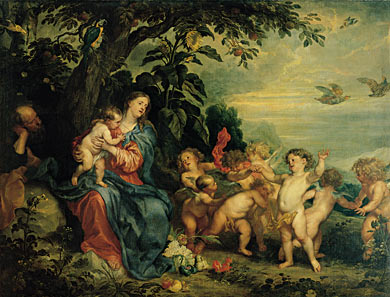 |
 |
 |
   |
 |
 |
 |
|
The Hermitage's Virgin with Partridges stands out noticeably from Anthony Van Dyck's other religious paintings in its wealth of symbolic detail included in the composition. The painting's subject—the rest of the Holy Family during the flight into Egypt, an episode from Christ's childhood—harks back to apocryphal texts. It became popular in the Netherlands in the early sixteenth century. When treating this theme, artists usually represented the Holy Family in the bosom of nature. Van Dyck remained within this tradition, placing the Madonna with the Christ Child and Joseph leaning on a rock under an apple tree, against a background of a landscape receding into the distance at the end of the day. Mary is holding the Child, standing on her lap and reaching toward a merry line of cherubs who want to amuse Him with their games and dances. This cheerful line takes up most of the composition, almost its central position, for the artist has shifted the group of main characters almost to the edge.
The painting has lush depictions of flowers and birds, which in the eighteenth century were considered to be "unnecessary" details that "overloaded" the composition, since by then its complex symbolism had been forgotten. Yet each detail has a hidden meaning. Thus, the fruit-covered tree beneath which the Holy Family sits is a direct indication that Mary is the new Eve and apparently symbolizes that Mary has overcome original sin by giving birth to the Savior. The sunflower arising in the center, above Mary's head, is not only part of the landscape but a personification of the inner, spiritual meaning of the depiction, indicating the divine essence of Mary as an undefiled Virgin. In this case, the parrot sitting on a branch to the left of Mary has the same meaning. Beyond the apple tree we see a white rose bush, and this flower was also an attribute of Mary, a symbol of her virginal purity, beauty, love, and joy. The partridges flying away from the Holy Family have another meaning. These birds were the attribute of one of the Deadly Sins—lust, and in the context of the painting embody the idea that Mary's purity chases away all that is sinful.
This symbolism was echoed in the cult of the Virgin Mary, which the Catholic Church in the early seventeenth century supported and propagandized to counter Protestantism, which considered the deification of Mary and the saints as a kind of idolatry. Wanting to attract as many worshippers as possible, the Catholic Church, and especially the Jesuit order, created special brotherhoods of Holy Mary throughout Europe. One was the Antwerp Confraternity of Bachelors, of which Van Dyck was a member and for which he painted two altar paintings—The Virgin and Child with Saints Rosalie, Peter, and Paul (1629) and The Mystic Marriage of the Blessed Herman Joseph (1630).
Researchers relate the works for the Antwerp Confraternity of Bachelors to the Hermitage's Virgin with Partridges, which by style can be dated with those paintings. Individual motifs of the painting have closest analogies in the works of Van Dyck dated 1629–32. Like many of the paintings by Flemish artists of those years, The Virgin with Partridges bears the mark of a fascination with Titian's work in the nobly majestic outlines of Mary's figure, and in the broad, smooth, and wavelike rhythm of the composition. And Venetian reminiscences lie at the base of the painting's conception. In particular, the figure of the Virgin with the child repeats, with insignificant changes (but in mirror reflection), an analogous group of figures in Titian's Doge Francesco Donato Adoring the Virgin and Child. A drawing of that group, made by Van Dyck during his stay in Italy, is found in one of his Italian sketchbooks. The composition of the Hermitage canvas is similar to some works by Rubens of that period, especially The Madonna and Child in a Landscape with St. George and Other Saints. However, there is not a trace of Rubens's clumsy infants. In Van Dyck's painting the movements of the cherubs are made slower and perhaps a bit too purposefully refined. In this restrained grace of the figures, and particularly in the soft muting and subtlety of the color harmony, there is a prefigurement of the sophisticated art of the next, eighteenth, century.
Van Dyck executed this work with the Antwerp painter Paul de Vos, who contributed the painted birds.
—Natalia Gritsay
|
|
|



